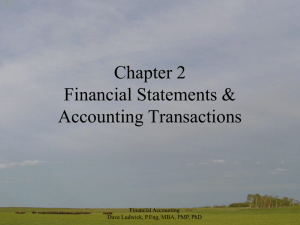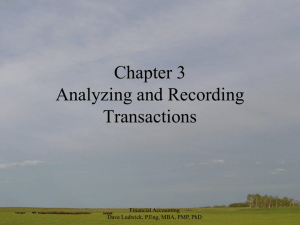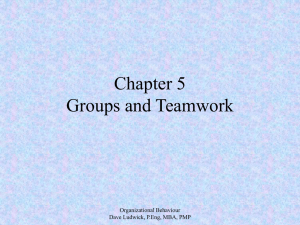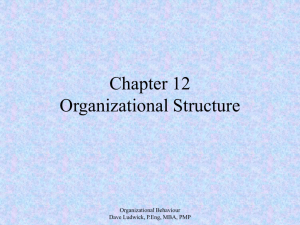Financial Accounting Chapter 4
advertisement
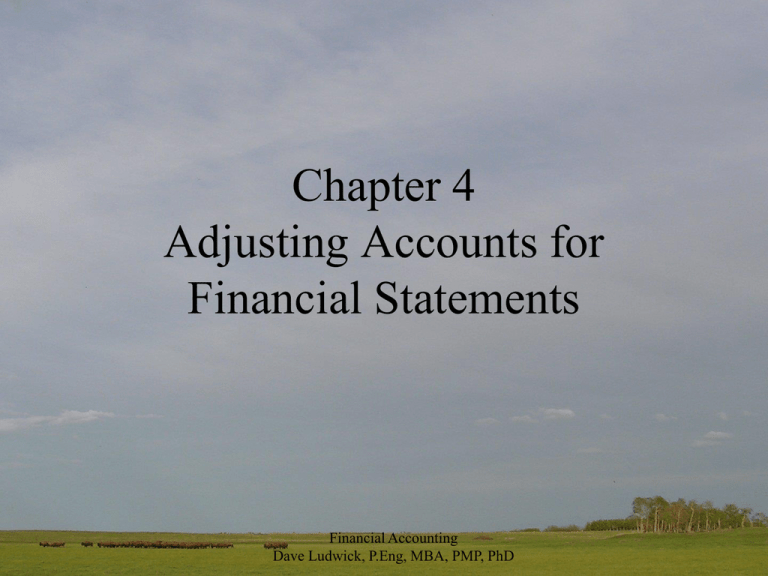
Chapter 4 Adjusting Accounts for Financial Statements Financial Accounting Dave Ludwick, P.Eng, MBA, PMP, PhD The Accounting Cycle • Chapter 4 covers the purple boxes plus Step 7 and Chapter 5 covers Steps 8 and 9 Financial Accounting Dave Ludwick, P.Eng, MBA, PMP, PhD Purpose of Adjusting • Until now, we have largely been processing “external transactions”, which are stimulated by exchanges with another party • But there are also “internal transactions” that must be entered in order to give a more complete picture of the organization’s performance during the period • Adjusting takes into account 3 of the GAAP rules – Time period principle – Revenue recognition principle – Matching principle Financial Accounting Dave Ludwick, P.Eng, MBA, PMP, PhD Time principle • As time passes, economic events or business transactions can be “deemed” to occur. • Consider the payment of rent. – Even though one pays rent in advance, the prepaid rent “asset” is actually “consumed” over the month or year for which it was paid • The time principle becomes especially evident when you consider the rent prepaid for a whole year. – If financial statements are prepared for each quarter, then adjustments must be made to recognize the portion of the prepaid rent that has been consumed into rent expense for that time of the year Financial Accounting Dave Ludwick, P.Eng, MBA, PMP, PhD Revenue and Expense Recognition • Revenue Recognition – Revenue is recognized (counted as an increase in the economic state of the organization) when there is evidence the firm is economically better off, regardless of when cash is received • Sale has been made • Products have been delivered to customers who are expected to pay • Sufficient time has passed to earn the revenue (rent revenues) • Matching Principle – The matching principle calls for the reporting or “matching” of expenses in the same accounting period as the revenues which they helped to create – Expenses are goods and services that are consumed in the creation of revenues – Costs associated with revenues that are to be earned in the future are maintained in asset accounts (or often called “capitalized”) and drawn against over future periods Financial Accounting Dave Ludwick, P.Eng, MBA, PMP, PhD Cash vs. Accrual Accounting Methods • Accrual Method – The method where revenues and expenses are recognized (recorded in financial statements) at the time they provide the economic impact, not necessarily when cash is received or disbursed • Cash Method – The method by which revenues and expenses are recorded when cash is received or disbursed • The Accrual method more closely supports the qualitative standards put forward by the accounting profession. It is a more conservative and relevant method. • The Accrual method supports the need for comparability • The Cash method is not consistent with GAAP Financial Accounting Dave Ludwick, P.Eng, MBA, PMP, PhD Example • Your company opens up shop on January 1, 2005. • On the first day you – Take possession of a new building you contracted to have built for your purposes – You arrange for hydro, water, telephone and cable service • Even though you may end up taking a mortgage to buy the building, you still do not record the complete purchase price of the new building on Jan 1. – You can’t expense a whole building in one day – it provides economic benefit (shelter in which you can earn revenue) for many years • However, at the end of the first quarter, you can expense all the utilities to that date, because they have already been (they are continually) consumed Financial Accounting Dave Ludwick, P.Eng, MBA, PMP, PhD Adjusting Accounts • An Adjusting Entry is recorded/entered at the end of the accounting period to bring the asset or liability account balance to its proper amount • The entry also adjusts the proper revenue or expense account • The 5 main adjustments (Exhibit 4.4) Financial Accounting Dave Ludwick, P.Eng, MBA, PMP, PhD Adjusting Prepaid Expenses • Prepaid expenses are items paid for in advance of receiving their benefits. Prepaid expenses are assets until they are consumed, which are adjusted into expenses – Remember the prepaid rent and prepaid insurance from previous examples? Date Account Titles and explanation PR Jan 1 Prepaid insurance Debit 3600 Cash Jan 31 Credit 3600 Insurance Expense 300 Prepaid insurance Financial Accounting Dave Ludwick, P.Eng, MBA, PMP, PhD 300 Amortization and Depreciation • Capital assets are long-term assets such as property, plant and equipment which are used to sell products/services over a long period of time (crossing over more than one accounting period) • Intangible assets are (generally long term assets) which provide some intangible benefit over a period of time (patents, trademarks, goodwill) • Amortization or depreciation is the process of “writing down” or expensing these assets over the course of their useful lives • The word “Depreciation” is used to refer to the write down of tangible assets and the word “Amortization” is used to refer to the write down of intangible assets Financial Accounting Dave Ludwick, P.Eng, MBA, PMP, PhD Calculating Amortization • Most common way is to use Straight Line depreciation • Example: – The business buys a delivery truck for $20000 on Jan 1 – The business expects to use the truck for 10 years, at which time it expects it could dispose of the vehicle for $2000 – Annual amortization: (20000-2000)/10 = $1800 / year Truck Book Value 20000 18000 16000 14000 12000 10000 8000 6000 4000 2000 0 1 2 3 4 5 6 7 8 9 Year Financial Accounting Dave Ludwick, P.Eng, MBA, PMP, PhD 10 Amortization terms • Cost of Asset/Purchase price: The original cash outlay required to acquire the asset • Salvage Value/Disposal Value: The amount that the asset can be disposed of for • Useful life: The number of accounting periods during which the asset contributes to earning revenue • Book Value: The cost of the asset less the accumulated depreciation during any period • Market Value: The amount the asset can actually be sold for at any given time. It is not recorded on the books unless the asset is actually sold Financial Accounting Dave Ludwick, P.Eng, MBA, PMP, PhD Mid-chapter Demonstration Problem • Lets try the Mid-chapter Demo Problem • Complete part A and B – journalize all the transactions • Bonus points (well, not really) – Draw a graph for Part A (b) showing how the accumulated depreciation of the tractor progressively reduces the book value of the tractor over its useful life Financial Accounting Dave Ludwick, P.Eng, MBA, PMP, PhD Contra Accounts • A contra account is an offset account in which the balance is always opposite and reported directly beneath, that of the account with which it is associated • Contra accounts allow balance sheet readers to know both the costs of assets and the total amount of depreciation charged to expense to date. • Sample Contra accounts – – – – Accumulated Depreciation (Fixed Assets) Accumulated Amortization (Intangible Assets) Allowance for Doubtful Accounts (Accounts Receivable) Bond Discount (Either a payable or asset, depending on the organization’s position) Financial Accounting Dave Ludwick, P.Eng, MBA, PMP, PhD Unearned Revenues • Unearned Revenues refer to cash received in advance of providing products or services. – When cash is received an obligation to provide products/services is accepted – Unearned revenues (aka deferred revenues) are liabilities until earned, when they get converted to revenues Date Account Titles and explanation PR Jan 1 Cash Debit 2000 Unearned revenue Jan 31 Credit Unearned revenue 2000 2000 Revenue 2000 Financial Accounting Dave Ludwick, P.Eng, MBA, PMP, PhD Accrued Expenses • Accrued Expenses refer to costs incurred in a period that are both unpaid and unrecorded. Accrued expenses are part of expenses and reported on the income statement • Example: – Accrued interest expense – Accrued salaries expense Date Account Titles and explanation Jan 28 Accrued salary expense PR Debit 750 Salaries payable Jan 31 750 Salaries Expense 250 Salaries payable 750 Cash Credit 1000 Financial Accounting Dave Ludwick, P.Eng, MBA, PMP, PhD Accrued Revenues • Accrued revenues are revenues earned in a period that are unrecorded and not yet received in cash • Relevant in a large project organization where revenue can be recognized at completion of various project phases, even though invoicing and payment may not occur for some time • I set up a separate Asset account for un-invoiced revenue, if it is not invoiced – Reserve the use of AR for invoiced but unpaid revenue Date Account Titles and explanation Jan 28 Un-invoiced revenue (not AR) PR Debit 750 Revenue Jan 31 Credit 750 Cash 750 Un-invoiced revenue Financial Accounting Dave Ludwick, P.Eng, MBA, PMP, PhD 750 Demonstration Problem • Lets try the Demonstration Problem. Lets create a – Balance Sheet, – Income Statement, – Statement of Owner’s Equity and • Along the way, – – – – journalize all the transactions Summarize them into T-account entries Create a trial balance Make sure you properly show the contra accounts on the Balance Sheet • Again, this is a representative question for the Mid-term exam Financial Accounting Dave Ludwick, P.Eng, MBA, PMP, PhD Onward… • Try problems – 4-14A, 4-6B • Chapter 5 Financial Accounting Dave Ludwick, P.Eng, MBA, PMP, PhD
